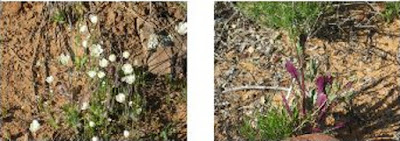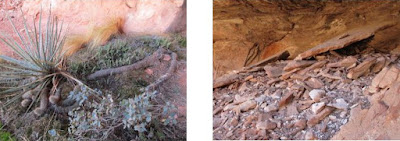On
4 February 2017 thirteen Skyliners (Jim Manning, Jim Gibson, Mark
Purcell, Karl Sink, Glen Sperry, Ellen McGinnis, Jim McGinnis, Joanne
Hennings, Joyce Arregui, Theresa [last name unknown], Daisy Williams,
Anita Jackson, and Frank Lombardo) drove through Camp Verde on Hwy
260 and parked on the left side of the road at mile marker 225.4.
The trail leaves the road through a permanently closed gate of heavy
pipe. There is room at this location to park 5 or 6 cars. This
parking area is arrived at before reaching Clear Creek. It is
necessary to pass through the closed gate by climbing between two
widely spaced pipes.
Even
though, we were really close to highway traffic we found that bushes
nearby were adequate cover for a restroom stop before starting out on
the trail. Caves up high on a cliff are visible from the beginning
of this well-traveled but unnamed trail. This hike includes both
cliff dwellings and other (pithouse) ruins. Fifteen Skyliners had
hiked here on 12 February 2011. A few of today's hikers had been on
that previous hike.
In
2011 I had been the last hiker to finish the climb up to the caves,
the last few hundred feet of which is very steep, requiring some hard
climbing to reach the first of the cave dwellings. The others that
day had already left the cave area when I arrived and I only had time
to take a couple of photos before hurrying to follow them. So I was
really glad that this time our leader, Jim Manning, gave us about
twenty minutes to explore all the caves that I had bypassed before.
 This
Photograph (right) shows stone and
mortar partial enclosure of a cliff dwelling and includes hikers
Theresa and Anita.
This
Photograph (right) shows stone and
mortar partial enclosure of a cliff dwelling and includes hikers
Theresa and Anita.
Just
below the cliff dwelling shown here I saw and photographed two
substantial pottery fragments (below
left). We found many other
potsherds scattered in various locations at this site. In keeping
with the custom for such locations, we just examined and photographed
them and left them in place for others to enjoy. A second cave with
stone and mortar enclosure is shown here (below
right).
 |
Pottery shards below dwellings Dwelling with a mortared opening
|
Below
Anita Jackson and Karl Sink are shown still exploring a cave while
Glen Sperry and Jim McGinnis are departing.
 |
Anita, Karl, Glen and Jim exploring a cliff dwelling
|
 From
the cave area we made our way on up to the top of the mesa where we
found a deep, narrow chasm (left)
separating two unequal parts of the mesa. The smaller part of the
mesa where we went next was covered with ruins. The ruins were
circles of low rock walls like the ruins of pit houses. To reach them
we had to climb up over some larger rocks on the way up. A good
example of these ruins is seen in the photograph below which shows
Ellen McGinnis sharing a particularly impressive pottery shard with
Frank Lombardo while Jim McGinnis quenches his thirst.
From
the cave area we made our way on up to the top of the mesa where we
found a deep, narrow chasm (left)
separating two unequal parts of the mesa. The smaller part of the
mesa where we went next was covered with ruins. The ruins were
circles of low rock walls like the ruins of pit houses. To reach them
we had to climb up over some larger rocks on the way up. A good
example of these ruins is seen in the photograph below which shows
Ellen McGinnis sharing a particularly impressive pottery shard with
Frank Lombardo while Jim McGinnis quenches his thirst. |
Ellen, Jim and Frank standing in the ruins atop the mesa
|
 Ellen
placed the pottery shard back atop the rock where she found it
(below right). Note that the fragment,
shown below, has a part of the rim still attached and a piece of
corncob is located nearby.
Ellen
placed the pottery shard back atop the rock where she found it
(below right). Note that the fragment,
shown below, has a part of the rim still attached and a piece of
corncob is located nearby. |
Looking back on the caves
in the wall of the mesa
|
Looking
back from the ruins atop the mesa, we could see the caves below (left) along
which we had followed the trail on the way up.
 Leaving
the smaller part of the mesa where the Indian ruins were located, we
crossed the chasm that separates the two parts and hiked uphill
through an area of creosote bushes (right)
toward the high point of the mesa. Creosote resin was used by Native
Americans as a glue; other parts of the plants were used medicinally.
Leaving
the smaller part of the mesa where the Indian ruins were located, we
crossed the chasm that separates the two parts and hiked uphill
through an area of creosote bushes (right)
toward the high point of the mesa. Creosote resin was used by Native
Americans as a glue; other parts of the plants were used medicinally.
When
we arrived at the top we were looking down on the Salt River
Materials Group Clarkdale Cement Plant's Gypsum Mine. Gypsum is used
as a cement retarder so that the cement dries more slower.
 |
Gypsum Mine
|
As
seen below, from the high point of the mesa we had a clear view all
the way to the San Francisco Peaks.
 |
Looking north to the San Francisco Peaks
|
 Rather
than returning by the trail we had followed past the caves to the top
of the mesa, we split into several groups that descended by different
routes, creating a real problem for our hike leader. Along the way
we passed some tall tree-sized Canotia holacantha plants (right).
This species is the most common of the crucifixion-thorns.
Rather
than returning by the trail we had followed past the caves to the top
of the mesa, we split into several groups that descended by different
routes, creating a real problem for our hike leader. Along the way
we passed some tall tree-sized Canotia holacantha plants (right).
This species is the most common of the crucifixion-thorns. Along
the way down the wall of the mesa there was a very old stump with
many roots (left) with only a few
of those roots still attached to the soil. This stump probably could
be dislodged very easily. I held my camera pointing downwards above
the stump to get a photo of the star-like arrangement of the roots.
Along
the way down the wall of the mesa there was a very old stump with
many roots (left) with only a few
of those roots still attached to the soil. This stump probably could
be dislodged very easily. I held my camera pointing downwards above
the stump to get a photo of the star-like arrangement of the roots.
In
his report1
of the 2011 hike in this area Ellis Price described two peaks
located below the mesa alongside Hwy 260, “two
small peaks visible from the mesa; one shows vegetation and one is
completely bare. I saw no indication of anything, such as a rock
layer, that would have caused the peaks to form naturally, and there
was no sign of a road that might have been used by heavy equipment.
I have no idea what produced them.”
He also provided the following photograph.
 |
Two small peaks at the foot of the mesa alongside Hwy 260
|
Curious
to see whether I could determine the origin of the peaks from an
up-close examination, I chose what appeared to be the easiest route
to them. I had thought that others in our group would have felt the
same curiosity and that I would meet them there.
However,
I found myself alone at the peaks. The only evidence of other human
activity was a few old footprints. As already noted we had started
the descent in several different groups; now the individual groups
had splintered, some making their loop shorter by going across the
face of the mesa to intersect the trail that we had ascended on and
some making a longer loop by heading more directly towards the
highway and then returning to the trailhead.
I
became concerned about being out of sight of everyone else while
examining the peaks. However I finally caught sight of Jim Manning
and waved to him. Jim waved back, indicating that he saw me, so I
lingered to take the following photographs. One of the peak with
sparse plant growth (below left)
and one of the bare peak (below right).
 |
Sparsely-covered peak Bare peak
|
As
I approached the sparsely-covered peak I first thought that maybe it
could have been a huge dump of useless product left over from the
Gypsum Mine operations. But, if that were true, where was the road
used by the dump trucks? The second smaller bare peak seemed to me
to resemble somewhat the mudstone formations that I had seen years
before in an area of the Grand Staircase Escalante National Monument.
A closer look at photos of both peaks gives a hint that if all the
white pebbly soil which covers the peak with vegetation were removed
then that peak might look much the same as the bare peak. And all
the white pebbly soil below the base of the bare peak looks as though
it has eroded down off of the peak.
The
geology of the Verde Valley is historically such that it sometimes
held lake water interspersed with periods when it completely dried up
leaving evaporites of salt and gypsum near the present town of Camp
Verde. During wet periods the lake was quite extensive. High lake
water left deposits of white limestone while low lake water left
deposits of brown mudstone.
On
leaving the peaks I was out of sight of the others for a long time
because I could not find any other safe way down from those peaks
than by retracing the route that I had taken in order to get there.
I
finally caught sight of a few of the other hikers. I had made it
down from the peaks and found a place where I could cross to the
other side of a gulch which separated me from them. Jim McGinnis had
backtracked looking for me. When I reached where Jim Manning was he
let me know that he had been concerned about what could have happened
to me.
After
following along Hwy 260 to rejoin the other hikers, already back with
the vehicles, Jim Manning reminded us that we should all try harder
to remain together as a group, keeping at least some of the other
hikers in sight at all times.
Editor's
note: No one made a GPS track of this hike, a major shortcoming in my
opinion, so I have used the track I made during the 2011 hike. The
route at least approximates the route taken by the author of this
report. The red track on the included map shows the route to the
top of the mesa; the blue track shows the 2011 return route.
This
report was written by Daisy Williams and assembled, edited and posted
online by Ellis Price with help from Lila Wright.

































